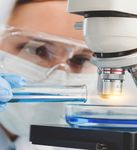Preparedness and response - to infectious disease outbreaks
←
→
Page content transcription
If your browser does not render page correctly, please read the page content below
Preparedness and response
to infectious disease outbreaks
11 NOVEMBER 2020
The EU has invested heavily in research
to improve epidemiology, modelling
and monitoring systems in response to
infectious disease outbreaks, such as
the COVID-19 pandemic. Research and
innovation, and collaborating with our
partners worldwide, remain vital to tackle
global health threats.”
Mariya Gabriel, Commissioner for Innovation, Research, Culture,
Education and Youth
A health threat emerging anywhere on the planet can quickly affect the rest of the
world. Infectious diseases now spread faster and farther and know no borders. That
is why the rapid development of health technologies right from the outset of an
emerging infectious disease outbreak is vital. This was highlighted when Ebola struck
in West Africa in 2014, and is now evident again in the battle against COVID-19.
The European Commission has invested heavily into research on preparedness and
response to infectious disease outbreaks, including for a public health emergency
like COVID-19, by:
> Investing in developing clinical networks and research infrastructures to ensure
preparedness to deliver clinical research;
> Boosting epidemiology research and modelling to develop better monitoring systems;
> Launching emergency research funding mechanisms.
The European Commission’s independent Group of Chief Scientific Advisors (GCSA),
the European Group on Ethics in Science and New Technologies (EGE) and Peter
Piot, special advisor to the President of the European Commission on the response
to COVID-19 have been providing and continue to provide independent expert
policy advice, including a joint Opinion on Improving pandemic preparedness and
management and a joint Statement on scientific advice to European policy makers in
the fight against the COVID-19 pandemic.
Research and
InnovationWOR KIN G ON A E U R O P E A N A N D G LO B A L S C ALE
The COVID-19 pandemic has confirmed the importance of planning and investing in research
and innovation before a health crisis occurs. Dialogue and collaboration between relevant or-
ganisations before an outbreak is key to supporting international and national research plans
and infrastructures. Some examples:
> As the need for stronger global collaboration in research preparedness became increasingly
clear, the Commission, alongside other funders, established the Global Research Colla-
boration for Infectious Disease Preparedness (GLoPID-R) network. It is an alliance of
research funding organizations across the world that facilitates effective and rapid research
response to outbreaks of infectious diseases by identifying priority research needs and
coordinating global research efforts.
> The European and Developing Countries Clinical Trial Partnership (EDCTP),
established in 2003 by the European Commission, together with European and
sub-Saharan African countries, exists to accelerate the clinical development of health
technologies for poverty-related and (re-)emerging infectious diseases. Two major EDCTP
initiatives, PANDORA-ID-NET and ALERRT, were established to strengthen the capacities of
African countries to respond to infectious diseases outbreaks.
T he Commission is supporting two international clinical research networks to treat COVID-19
and other emerging infectious diseases.
> EU-RESPONSE, builds on the DisCoVeRy trial originally initiated in France at the beginning of the
COVID-19 pandemic, in coordination with the WHO Solidarity trial. EU-RESPONSE is focusing on
the evaluation of repurposed medicines to treat COVID-19 in multi-centric clinical trials across
Europe, further including new experimental treatments as new knowledge emerges.
> The newly funded RECOVER project builds on longstanding efforts towards European preparedness
for epidemics, starting with PREPARE, the EU-funded Platform for European Preparedness Against
(Re-)emerging Epidemics. Established in 2014 to ensure that clinical research is built into epidemic
responses, PREPARE contributed to the establishment of REMAP-CAP, a research-platform
designed to be adapted during a pandemic. REMAP-CAP, further supported by RECOVER, is now
testing new therapeutic agents and/or supportive therapy for severe SARS-CoV-2 infection.
A key feature of EU-RESPONSE and RECOVER is their joint coordination mechanism to
ensure complementarity, harmonization and synergies with other European and international
initiatives in the field.
RE S E AR C H AND INNOVATION P R OJEC TS
Investing in preparedness and response actions, projects and initiatives remains a
top priority for the European Commission. Some examples:
> ZAPI project works to enable a swift response to new infectious diseases by
designing new manufacturing processes for delivering effective control tools
against (re-)emerging zoonotic diseases.
> COMPARE project aims at speeding up the detection of and response to disease
outbreaks among humans and animals worldwide through the use of new genome
technology. COMPARE was launched in 2014.
> VEO project was built on parts of the partnership developed through the COMPARE
project. VEO established an interactive virtual observatory for the generation
and distribution of high-quality actionable information for evidence-based early
warning, risk assessment and monitoring of emerging infectious diseases threats.
> MOOD project aims to develop innovative tools for the early detection,
assessment, and monitoring of infectious disease threats across Europe.
Moreover, the Commission has required all Horizon 2020 consortia with research
outputs that may, in any way, be used to advance the research on COVID-19, to
provide immediate open access to their related publications/data. The research
projects are expected to apply the principles established in the Statement on Data
Sharing in Public Health Emergency, to which the European Commission is a signatory.
2N E W PR OJEC TS R ES P ONDING TO THE C OV ID-19 C R IS IS
A N D FUTUR E EP IDEMIC S
Building on previous investments, and responding to the current and future
crises, the Commission launched an emergency call (January 2020) through which
18 projects, involving 151 teams from across Europe and beyond, were granted
funding. Some examples:
> The I-MOVE-COVID-19 project aims to obtain epidemiological, clinical and
virological information on coronavirus and infected patients through a
surveillance network. Such networks are key to be able to effectively understand
and manage the spread of the virus.
> In collaboration with European Centre for Disease Control (ECDC), we aim to
identify and understand the consequences of epidemic-control decisions. The
EpiPose project strives to understand the social dynamics of, and the public
health response to, the COVID-19 pandemic.
A subsequent call was launched (May 2020) to complement the efforts of the first
call. With €128 million 23 research projects will be funded, including:
> Orchestra project is creating a new pan-European cohort applying
homogeneous protocols for data collection and sharing, sampling, and follow up,
which will rapidly advance the knowledge on the control and management of
COVID-19.
> UnCoVer project will work with ongoing cohorts and longitudinal registries to
collect new and harmonize existing data for prognosis and prediction at the
individual and population levels, while laying the foundation for fast-tracked,
evidence-based cross-national response to future epidemics.
H O RI Z ON EUR OP E (2021-2027)
Horizon Europe, the next research and innovation framework programme, will
further build on these investments, promoting and protecting human health and
well-being, for a healthier society. Capitalising on, and further strengthening, our
investments in research and innovation for infectious diseases will allow us to be
better prepared for future epidemics and equipped for their recovery.
Coronavirus research and innovation
#EUHealthResearch
#ResearchImpactEU
#UnitedAgainstCoronavirus
© European Union, 2020
Reuse of this document is allowed, provided appropriate credit is given and any changes are indicated (Creative
Commons Attribution 4.0 International license). For any use or reproduction of elements that are not owned by the
ISBN: 978-92-76-25133-0 EU, permission may need to be sought directly from the respective right holders.
DOI:10.2777/08620 All images © European Union, unless otherwise stated. © Maksim Šmeljov #327945641; © sdecoret #324486567;
KI-01-20-697-EN-N © s_l #279508721; © billionPhotos #229894738, 2020. Icons © Flaticon – all rights reserved.
3You can also read






















































